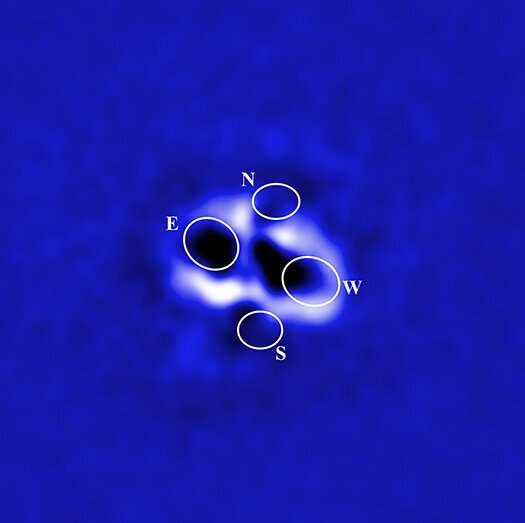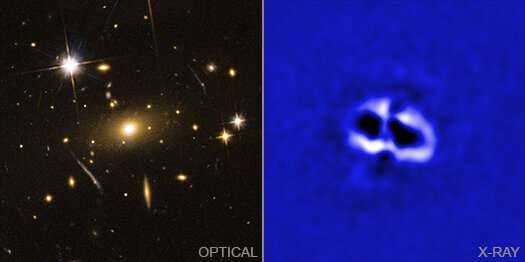These types of cavities have been seen before in other galaxy clusters. Scientists think they are the result of eruptions from regions near a supermassive black hole in the middle of the massive central galaxy. As matter flies away from the black hole as jets in opposing directions, it blows cavities in the hot gas. The revelation in RBS 797 is that there are two sets of jets directed perpendicular to each other.

"We think we know what a pair of cavities represents, but what is going on when a galaxy cluster has two pairs in very different directions?" said Francesco Ubertosi of the University of Bologna in Italy, who led the Chandra study.
Astronomers previously observed the pair of cavities in the east-west direction in RBS 797, but the pair in the north-south direction was only detected in a new, much longer Chandra observation. The deeper image uses almost five days of Chandra observing time, compared to about 14 hours for the original observation. The National Science Foundation's Karl G. Jansky Very Large Array had already observed evidence for two pairs of jets as radio emission, which line up with the cavities.
How was this quartet of cavities created? The most likely answer, according to Ubertosi and his colleagues, is that RBS 797 contains a pair of supermassive black holes that have launched jets in perpendicular directions at almost the same time.
"Our best idea is that one pair of supermassive black holes has led to a pair of a pair of cavities," said Myriam Gitti, a co-author also of the University of Bologna. "While we think supermassive black holes can form binary systems, it is extremely rare that both of them are observed in an active phase—in this sense the discovery of two close active black holes inflating cavities in RBS 797 is extraordinary."
Indeed, previously a radio observation with the European VLBI Network (EVN) discovered two radio point sources separated by only about 250 light-years in RBS 797. If both sources are supermassive black holes, they are among the closest pair ever detected. The two black holes should continue to spiral toward each other, generating huge amounts of gravitational waves, and eventually merge.
There is another possible explanation for the four cavities seen in RBS 797. This scenario involves only one supermassive black hole—with jets that somehow manage to flip around in direction quite quickly. Analysis of the Chandra data shows that the age difference for the east-west and north-south cavities is less than 10 million years.
"If there is only one black hole responsible for these four cavities, then we will have to trace the history of its activity. Key aspects are how the jets' orientation changed quickly, and whether this is related to the galaxy cluster environment or to the physics of the black hole itself—or even a combination of both," said Fabrizio Brighenti, a University of Bologna co-author.
NASA's Marshall Space Flight Center manages the Chandra program. The Smithsonian Astrophysical Observatory's Chandra X-ray Center controls science from Cambridge Massachusetts and flight operations from Burlington, Massachusetts.



